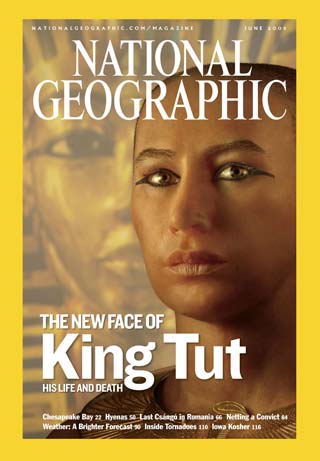
King Tut

Egypt's boy pharaoh has fascinated the world since the first glimpse of his tomb in 1922. Now modern forensics and high-tech imaging offer new insights into his life—and death.
|
|
| He was just a teenager when he died. The last heir of a powerful family that had ruled Egypt and its empire for centuries, he was laid to rest laden with gold and eventually forgotten. Since the discovery of his tomb in 1922, the modern world has speculated about what happened to him, with murder the most extreme possibility. Now, leaving his tomb for the first time in almost 80 years, Tut has undergone a CT scan that offers new clues about his life and death—and provides precise data for an accurate forensic reconstruction of the boyish pharaoh. Inside King Tut's subterranean burial chamber, against a backdrop of sacred murals, Zahi Hawass, head of Egypt's Supreme Council of Antiquities, removes padding to reveal the young pharaoh's remains. "When I saw his face, I was shocked," says Hawass. "My heart was pounding, and I could not speak." Moments later, workmen carried the mummy—still in the plain wooden box where British archaeologist Howard Carter placed it decades ago—to a trailer parked at the entrance of the tomb. There, a CT machine scanned the mummy head to toe, creating 1,700 digital x-ray images in cross section. Tut's head scanned in .62-millimeter slices to register its intricate structures, takes on eerie detail in the resulting image. With Tut's entire body similarly recorded, a team of specialists in radiology, forensics, and anatomy began to probe the secrets that the winged goddesses of a gilded burial shrine protected for so long. Clues From Top . . . Did the young pharaoh die from a blow to the head? Definitely not, say the nine doctors who studied the CT images. Some Egyptologists and amateur sleuths have long speculated that a stealthy foe murdered Tut by attacking him from behind. As evidence, they cite an x-ray taken in 1968, which shows a fragment of bone (A) in the skull cavity—emptied by embalmers, according to custom. The CT scan, however, found no trace of lethal trauma to the head. A cross section reveals two loose pieces of bone (B and C), as well as additional chips embedded in the embalming resins that line the top and back of the skull. Packing material also appears near the ear canals and in the sinus cavities, and plugs close the nostrils. To remove the brain, pour in the resins—at two separate times—and stuff in the packing, the embalmers apparently entered the skull through the nose as well as the neck (D), perhaps breaking off bone in the process. Carter's handling of the mummy may also have produced bone fragments. The maturity of the skeleton and wisdom teeth (E, one circled) confirms that Tut was about 19 years old when he died. His teeth had no cavities, and though his palate had a small cleft, he was probably unaware of it. The elongated shape of his skull—similar to that of other family members—was not caused by disease and falls within the range of normal variation. . . . to Bottom About five feet six inches tall (1.7 meters) and slightly built, Tut was in excellent health—well fed and free of any disease that would have affected his physique. Though his spine appears curved, it was probably misaligned during embalming. Something out of the ordinary, then, must have struck him down. But what? The experts can't say for sure because of the difficulty in distinguishing between possible injuries to Tut while alive and the damage Carter's team did to the mummy. Some believe, for instance, that a fracture above the left knee was Carter's fault. Others think it may be the result of an accident or assault that led to Tut's demise after a virulent infection set in and spread. Tut's funerary equipment—including chariots, bows, arrows, and throwing sticks —indicates that he had learned to hunt and fight like a proper pharaoh. In addition, a painted wooden box (above) shows him defending Egypt from its enemies, a symbolic scene but maybe based in truth. Could he have died in battle? Or might he have crashed his chariot while hunting? Supporters of such possibilities point to Tut's mangled chest, with its breastbone missing and much of the front rib cage cut out. Carter's anatomist notes that resin-soaked linen packed in Tut's chest prevented an examination—so the bones were likely not removed at that time. Did the embalmers take them out while preparing a gravely injured Tut for eternity? It's an intriguing question, but for now the pharaoh is still keeping some secrets. |